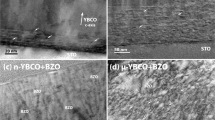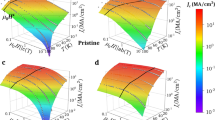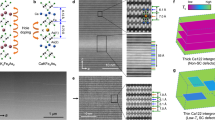Abstract
Thin films of the high-temperature superconductor YBa2Cu3O7−δ exhibit both a large critical current (the superconducting current density generally lies between 1011 and 1012 A m−2 at 4.2 K in zero magnetic field) and a decrease in such currents with magnetic field that point to the importance of strong vortex pinning along extended defects1,2. But it has hitherto been unclear which types of defect—dislocations, grain boundaries, surface corrugations and anti-phase boundaries—are responsible. Here we make use of a sequential etching technique to address this question. We find that both edge and screw dislocations, which can be mapped quantitatively by this technique, are the linear defects that provide the strong pinning centres responsible for the high critical currents observed in these thin films. Moreover, we find that the superconducting current density is essentially independent of the density of linear defects at low magnetic fields. These natural linear defects, in contrast to artificially generated columnar defects, exhibit self-organized short-range order, suggesting that YBa2Cu3O7−δ thin films offer an attractive system for investigating the properties of vortex matter in a superconductor with a tailored defect structure.
This is a preview of subscription content, access via your institution
Access options
Subscribe to this journal
Receive 51 print issues and online access
$199.00 per year
only $3.90 per issue
Buy this article
- Purchase on Springer Link
- Instant access to full article PDF
Prices may be subject to local taxes which are calculated during checkout




Similar content being viewed by others
References
Hylton, T. L. & Beasley, M. R. Flux-pinning mechanisms in thin films of YBa2Cu3O7−δ. Phys. Rev. B 41, 11669–11672 (1990).
Douwes, H., Kes, P. H., Gerber, Ch. & Mannhart, J. Critical currents in YBa2Cu3O7−δthin films containing screw dislocations. Cryogenics 33, 486–491 (1993).
Gerber, Ch., Anselmetti, D., Bednorz, J. G., Mannhart, J. & Schlomm, D. G. Screw dislocations in high-Tcthin films. Nature 350, 279–280 (1991).
Hawley, M., Raistrick, I. D., Beery, J. G. & Houlton, R. J. Growth mechanism of sputtered films of YBa2Cu3O7−δstudied by scanning tunneling microscopy. Science 251, 1587–1589 (1991).
Mannhart, J.et al. Correlation between Jc& screw dislocation ddensity in sputtered YBa2Cu3O7−δfilms. Z. Phys. B 86, 177–181 (1992).
Pan, V. M., Kasatkin, A. L., Svetchnikov, V. L. & Zandbergen, H. W. Dislocation model of superconducting transport properties of YBCO thin films and single crystals. Cryogenics 33, 21–27 (1993).
Lowndes, D. H.et al. Strong asymmetric flux pinning by miscut-growth-induced columnar defects in epitaxial YBa2Cu3O7−δfilms. Phys. Rev. Lett. 74, 2355–2358 (1995).
Diaz, A., Mechin, L., Berghuis, P. & Evetts, J. E. Evidence for vortex pinning by dislocations in YBa2Cu3O7−δlow-angle grain boundaries. Phys. Rev. Lett. 80, 3855–3858 (1998).
Dam, B.et al. The laser ablation threshold of YBa2Cu3O7−δas revealed by projection optics. Appl. Phys. Lett. 65, 1581–1583 (1994).
Vasquez, R. P., Hunt, B. D. & Foote, M. C. Wet chemical techniques for passivation of YBa2Cu3O7−δ. Appl. Phys. Lett. 53, 2692–2694 (1988).
Roshko, A.et al. Effects of etching on the morphology and surface resistance of YBa2Cu3O7−δfilms. IEEE Trans. Appl. Supercond. 5, 1733–1736 (1995).
Heimann, R. B. Ausflösung von Kristallen(Springer, Wien, (1975).
Freisem, S., Brockhoff, A., de Groot, D. G., Dam, B. & Aarts, J. Magnetic & transport propertiees of sputtered La0.67Ca0.33MnO3thin films. J. Magn. Magn. Mater. 165, 380–382 (1997).
Dam, B.et al. Growth and etching phenomena on pulsed laser deposited YBa2Cu3O7−δfilms. Physica C 261, 1–11 (1996).
Blatter, G., Feigel'man, M. V., Gershkenbein, V. B., Larkin, A. I. & Vinokur, V. M. Vortices in high-temperature superconductors. Rev. Mod. Phys. 66, 1125–1388 (1994).
Nelson, D. R. & Vinokur, V. M. Boson localization and correlated pinning of superconducting vortex arrays. Phys. Rev. B 48, 13060–13097 (1993).
Civale, L. Vortex pinning and creep in high-temperature superconductors with columnar defects. Supercond. Sci. Technol. 10, A11–A28 (1997).
Krusin-Elbaum, L., Civale, L., Thomson, J. R. & Field, C. Accomodation of vortices to columnar defects: Evidence for large entropic reduction of vortex localization. Phys. Rev. B 53, 11744–11750 (1996).
Qvarford, M., Heeck, K., Lensink, J. G., Wijngaarden, R. J. & Griessen, R. Microtorquemeter for magnetization measurements on small superconducting samples. Rev. Sci. Instrum. 63, 5726–5732 (1992).
Schnack, H. G., Griessen, R., Lensink, J. G. & Hai-Hu, W. Generalized inversion scheme for the determination of activation energies from flux-creep experiments on high-Tcsuperconductors. Phys. Rev. B 48, 13178–13182 (1993).
Gao, Y., Merkle, K. L., Bai, G., Chang, H. L. M. & Lam, D. J. Structure & composition of graiin boundary dislocation cores and stacking faults in MOCVC-grown YBa2Cu3O7−δthin films. Physica C 174, 1–10 (1991).
Acknowledgements
This work is part of the research program of FOM (Fundamenteel Onderzoeck der Materie) which is financially supported by NWO (Nederlands Wetenschappelijk Onderzoek). A.M.T. thanks the National Research Council of Italy (CNR) for financial support.
Author information
Authors and Affiliations
Corresponding author
Rights and permissions
About this article
Cite this article
Dam, B., Huijbregtse, J., Klaassen, F. et al. Origin of high critical currents in YBa2Cu3O7−δ superconducting thin films. Nature 399, 439–442 (1999). https://doi.org/10.1038/20880
Received:
Accepted:
Issue Date:
DOI: https://doi.org/10.1038/20880
This article is cited by
-
Dislocation interactions during plastic relaxation of epitaxial colloidal crystals
Nature Communications (2023)
-
Impact of deoxygenation/reoxygenation processes on the superconducting properties of commercial coated conductors
Scientific Reports (2023)
-
Impact of high growth rates on the microstructure and vortex pinning of high-temperature superconducting coated conductors
Nature Reviews Physics (2023)
-
Improvement in the superconducting properties of YBa2Cu3O7-d material via PbO addition
Journal of Materials Science: Materials in Electronics (2023)
-
Anisotropic dislocation-domain wall interactions in ferroelectrics
Nature Communications (2022)
Comments
By submitting a comment you agree to abide by our Terms and Community Guidelines. If you find something abusive or that does not comply with our terms or guidelines please flag it as inappropriate.



